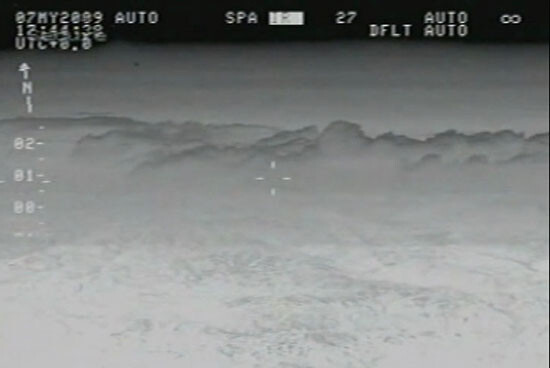I. “Enemies’ dead strewed the town”
At the British Library, dispatches from the frontlines of England’s merciless 1857 to 1858 counterinsurgency campaign in India are collected into folders marked “Miscellaneous Indian Mutiny Papers” and “India Office Records and Private Papers.” They read as a perverse and staccato kind of poetry, shaping tidings of insurrection and its suppression into the idiom of war-state bureaucracy, a jargon further formalized during its compression into the argot of electronic telegraphy.
One of these communiqués, marked “Copy of message received by Electric Telegram” and dated August 17, 1857, was sent from General Havelock in Cawnpore (Kanpur) to his superiors in Calcutta, and reports a qualified victory over the massed peasants then arrayed against British paramountcy. Insurgents captured some cannon, Havelock relays, “But enemies’ dead strewed the town—I estimate their loss of three hundred killed & wounded.”1 It is an everyday update during this long campaign, an event hardly worthy of notice and occasioning nothing beyond straight accounting of enemy casualties: part of the paperwork of empire. The message is copied in barely legible handwriting; the form is marked, “Calcutta, Elec. Tel. Office, 17 Aug’t 1857,” verified again (“A true copy”), and finally signed in pencil with a clerk’s name. These signatures verify the contents’ correct transcription from the telegraphic original. They show us that this act of state killing has been reported by dictation, transcribed into writing, configured into telegraphic code, transmitted over vast distances of copper wire, received, decrypted, transcribed by hand (in pencil) onto a telegraphic form, and then copied longhand and finally double verified by a functionary who signs his own name: J. S. Seale, LT. Elaborately mediated yet insisting via seal and signature on its perfectly lossless transmission, the document, like many others during the Victorian era’s long war—no single year of the Queen’s reign was without armed conflict—is a document of asymmetrical warfare that insists most of all on its status as an act of mediation.
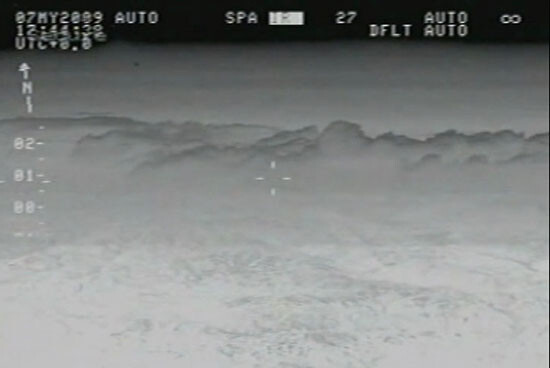

II. Cycles, Ends
A century and a half after the “liberation” of Cawnpore, in our own era of endless war, it is clear that the question of liberal violence and its mediations is not only a Victorian one. In The Long Twentieth Century, Giovanni Arrighi draws attention to the way that successive cycles of imperial power echo one another. In macroeconomic terms, he parses the wave-based logic of accumulation by which “patterns of recurrence and evolution” stretch over successive phases of world leadership: Genoese, Dutch, British, and American all in a row.2] (London: Verso, 2002), 6.] We can certainly hear more than a little of Pax Britannica in the rhetoric of late American empire. Today, however, forms of mediation that were central to the normatively demarcated “culture” of the nineteenth century—poetry and the literary novel, say—are no longer dominant but have become residual or even niche categories, boutique commodities for a narrow subset of often self-consciously nostalgic consumers. The technologies for delivering violence have changed, too; bayonet, telescope, and cannon have been replaced by illuminated night-vision and long-distance drone strikes. What is the relationship between our contemporary means of distributing death, and the aesthetic forms by which that death is transmitted, recoded, mediated? And do these shifting relations tell us anything about our place in the cycle of American empire that Arrighi sees as already showing “signs of autumn”?3
My sense is that militarized drones, those machines for remote seeing and killing known in military jargon as “Unmanned Aerial Vehicles,” should be understood to signify an end of empire in two senses. First, an end as in conclusion, or terminus. Hannah Arendt argued that proliferating death is not a sign of an emerging or persisting hegemony but its waning: “rule by sheer violence,” she notes, “comes into play where power is being lost.”4 This means that the assassinations proliferating in the name of the American phase of accumulation are the sign not of its strength but its incipient weakness; never mind autumn, we could say that drone war is a sign of the coming winter. Second, I mean an end in the Aristotelian sense of telos, or purpose. If we take seriously the fact that empire is best understood not as a culture or as a discourse but as the monopoly on putatively legitimate violence—the stretching of the state’s power over life and death past the boundaries of its “own” populace—then the power of sovereign decision crystallized in globally operated, remote assassination machines is the very essence of empire: its telos, or end. President Obama’s now-infamous “kill list meetings” sharpen to an obscene purity the American state’s power of judgment over life and death beyond its own citizenry and constitute the distillation of imperium as such.
Drones are at once a symptom and a realization of the empire’s end. But they are also a regime of figuration, a way of seeing, and, therefore, a modality of thought. In the words of Roger Stahl, drones have “capacity as a medium.”5 Even a small survey of the work that has drawn on the drone’s odd coincidence between media form and instrument of sovereignty would stretch across the field of cultural production. It might start with vernacular forms like Twitter bots, public art installations, and even the anxious dreams recorded in the drawings of victims, but would move all the way to the self-consciously rarefied idiom of gallery and museum art, to works attempting to represent critically the ontological and political, and therefore also aesthetic, novelties generated by our drone era. There is even a clutch of mass-market novels about drones produced for a global Anglophone audience. Seen together, what the cheaply printed bestsellers and high-art photography hint at is a comparative analysis of the aesthetic technologies that have emerged to mediate our endless, late-imperial war.


III. Consolidated Vision
The visual rhetoric of drone optics—targeting, sighting, framing, flight data, conspicuous pixilation—has become a cliché, evolving from an arresting graphic novelty into a part of our everyday imageworld: UAV optics structure million-hit YouTube videos of drone kills,6 but also video game franchises, big-budget films, and television dramas up and down the scale of so-called “quality.”
But drone vision is not only about crosshairs and black-and-white targets. As Gregoire Chamayou explains in The Theory of the Drone, the regime of perception inaugurated by the drone involves at least three principles: (1) persistent surveillance or permanent vigilance in the present; (2) a totalization of perspectives or synoptic viewing, covering all space; and (3) total archival retention, aggregating surveillance diachronically in storage. All of this adds up to what Chamayou calls a “revolution in sighting.”7 The US Air Force’s incredibly named Gorgon Stare program, for example, offers what its advocates call an “unrelenting gaze.” Mounted on a “hunter-killer” MQ-Reaper, which can hold two tons of weaponry and remain airborne fully loaded for fourteen hours, the Gorgon Stare setup uses 192 different cameras, and can store the data it collects for thirty days, enabling “after-action forensic operation,” a diachronic capacity that makes this technology “the number-one reconnaissance asset that warfighters crave,” not least because it allows the state to “discern patterns in the behavior of insurgents—where they hid, how they operated, who they interacted with—that would have been unknowable using other surveillance systems.”8
Diachronic, totalizing, and aspiring to omniscience, drone form is also predicated on massive asymmetries of perspective. As Chamayou notes, the drone eliminates reciprocity from the scene of killing and turns seeing, and with it the risk of death, into a one-sided operation: I see you but you don’t see me, and a drone operator at Creech Air Force Base in Nevada can kill but is not himself at risk of being killed. This has tactical and legal ramifications but is also a political-aesthetic problem. It means that the dilemma of unevenly distributed narrative space that Edward Said detailed in Culture and Imperialism—where the core speaks and has the power to act, while the margins figure only as silence—now describes the tactical raison d’etre of a new war-making technology, its operational advantage. Said argues that the empire is “only marginally visible,” barely perceptible to the metropole but nonetheless crucial, “very much like the servants in grand households or in novels.”9 Said’s argument about uneven representation within the novel has been critiqued for construing imperial power as a representational or cultural problem, rather than a properly political one. He slips easily from describing optics to power, silently analogizing “vision” with political sovereignty by referring, in a chapter called “Consolidated Vision,” to “what I have been calling … consolidated authority.”10 Representational capacity is not identical to political authority, but drone technology helps us see that in fact “consolidated vision” was always naming a problem of sovereignty. Drone form makes this explicit, since it twins representational capacity—the power to see and to observe or, as Said has it, to narrate—with the capacity to kill.
Iraqi born artist Wafaa Bilal exposed the perversity of this spatial dissymmetry in Domestic Tension (2007), a thirty-day performance piece in which he sat in a room while internet users across the world, anonymously and at any time, could click a button to shoot him with a paintball gun. Other artists, working yet more explicitly in the idiom of drone war, have attempted to redistribute the uneven representational and political space on which remote killing depends. Khesrau Behroz’s Everybody knows where they were when they heard that Kennedy died begins from an app that sends push notifications to its users as soon as a drone strike is reported. These notifications include details of the numbers killed and wounded, the location of the attack, and, occasionally, a brief description of the scene. The collages Behroz made using this app depict screenshots of drone execution notifications juxtaposed with “a picture of where I was when I heard about the news.” The result sets a space of precarity against one of safety, and underscores the perverse anonymity of these killings: unlike in the Kennedy assassination for which the series is named, no one is encouraged to remember where they were when these unnamed individuals die. The work also highlights the obscenity of our ability to ask, from a position of safety, questions like: Where were you when “a drone strike outside Marib killed two people in a car”? Or when “a US drone fired missiles at a house, killing four”?
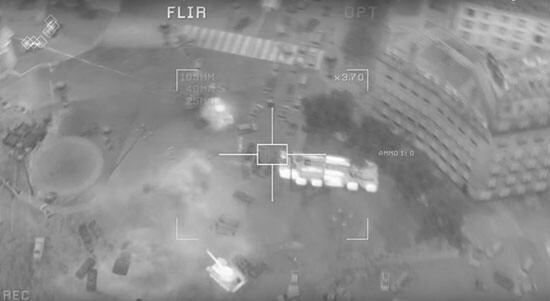

The digital chromogenic prints of multimedia artist Trevor Paglen—vast in format, variously opaque and hyperreal in their macro-scaled high resolution—seek to reverse or reorient the protocol of seeing that is constitutive of the drone state. From a citizen’s point of view they watch the state, depicting secret interrogation sites, half-visible drones, and private tarmacs used to transport detainees to overseas gray zones for torture. The artist uses long exposures to reveal the orbits of secret government surveillance satellites in transit, thus inverting the state’s powers of vision to disclose what is for citizens normally occluded. I write “depict,” “reveal,” and “disclose,” but the point is that these images aim to defuse the desire for immediacy and presence that is inherent to drone vision and that structures war-state informatic logic more broadly—or so the mutiny telegram I mentioned above would suggest.
Rather than the frictionless transfer of information or “documentary” accuracy, Paglen’s work aims, in his words, to be “useless as evidence … I want photography that doesn’t just point to something, it actually is that something.”11


The point is not to bring into focus the thing observed but the technologies of seeing themselves, and an image like Untitled (Reaper Drone) (2010), for example, from his series of quasi-abstract drone photographs from 2009–10, announces itself as a grandly beautiful depiction of color itself. Its wash of graduating blue-red references mid-century color-field painting by artists like Newman and Rothko no less than that earlier phase of industrialized life captured by J. M. W. Turner in his smeared depictions of Victorian ecocide. With concentration, this haunted vacancy becomes legible as an evening sky. The Reaper drone flecking the side of the frame, once noticed, becomes the photograph’s maddening focal point, impossible to unsee. Instead of objects or content these images show walls of distance, highlighting the forms of mediation—aesthetic, technological, spatial—separating it from us.
Of course, even as they comment critically on militarized techniques of observation, Paglen’s self-consciously high-cultural artifacts occupy an elevated place in the contemporary culture industry, hanging in galleries and museums and acquiring the fetish character that remains the sine qua non of contemporary art. Yet Paglen is rare among this milieu in his commitment to weaponizing this very art-world success. This strategy of immanent critique is evident, for example, in Paglen’s dissident public works like Code Names of the Surveillance State, where he projected NSA code names onto the British Parliament; his monumental Tube stop installations like An English Landscape (American Surveillance Base near Harrogate, Yorkshire); and his work (as producer and provider of still images) for Laura Poitras’s documentary about Edward Snowden, Citizenfour.
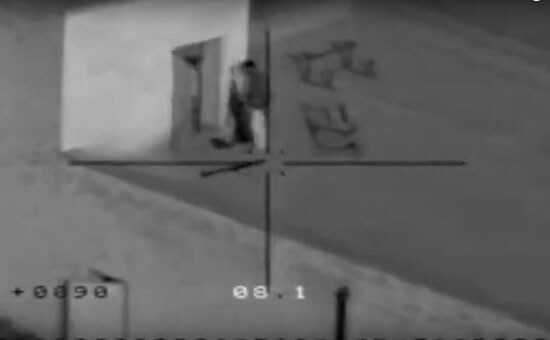

IV. Sting of the Drone
To shift from the “restricted” to the unrestricted end of the Bourdieusian field of cultural production, I move from the gallery spaces of “art-as-pure-signification” to the “field of large-scale cultural production,” where art is capital and the point is to sell in volume.12 The “drone thriller” is a new subgenre of fiction that has begun to occupy a niche, albeit a small one, in the contemporary mass market for literature. These emergent forms are pitched as stories for a new era, but triangulate themselves within well-established conventions in the literary middlebrow. The cover of Dan Fesperman’s Unmanned (2014) announces the book as “part mystery and part thriller”; while Sting of the Drone (2014), a clunky exercise by former US counterterrorism czar Richard A. Clarke, is unmistakably a “thriller”—unmistakable because the word is repeated five times on its back cover. (“This first rate thriller,” one anxious blurber says, is “a cross between a techno-thriller and a docu-thriller.”) Most delightful is Mike Maden’s “Troy Pearce” series of “intense page-turners,” whose phallically named, eponymous hero is “still lean and cut like a cagefighter despite the strands of silver in his jet-black hair.”13 Pushed out in quick sequence, the series kicks off with Drone (2013) and moves through Blue Warrior (2014) and Drone Command (2015).14
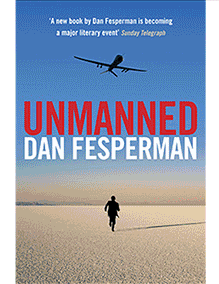

A series of covers exemplify the growing genre of the “drone thriller” novels.
As all these names and titles suggest—Warrior, Command, Pearce—Maden’s intervention into the new subgenre is a kind of masculine fantasia. In defiance of the rules of perspective it includes full specifications for every gun and piece of war-making technology to grace its pages, and features a no-nonsense female president, her frame “strong and lean” from “years of swimming and Pilates,” who drinks bourbon and shows no patience for fussy questions of human rights.15 In Maden’s plot, the lean and gym-toned president leagues with the cagefighter Pearce to scrub the world of Mexican gangsters and Iranian terrorists. The fantasy president from Texas nonetheless balances her badassery with fetching maternal instincts, nearly starting a pointless and politically suicidal war with Mexico—but only to avenge the death of her son.16 “She had a bigger nutsack than any man he knew in politics,” Pearce reflects.17 The novel’s adolescent gaze leaves no piece of equipment or human body unadmired, though its taste runs toward the conventional: a scientist has “long legs, soft curves, and cloying eyes … more like a Bollywood movie star than a Ph.D in robotics engineering,” while the enemy (and male) Castillo twins are “naked and tan, their muscled bodies glisten[ing] with sweat.”18 As a character, Pearce himself is ripped from the rhetorical vocabulary of ads for impotence drugs: he drinks beer and splits logs shirtlessly between fishing trips and sexual conquests, all while organizing assassinations by robot.19
The book’s infantile sexuality (I hesitate to call it eroticism) does work, however, because as Chamayou notes, the constitutive absence of reciprocity in drone technology—what one Air Force pamphlet calls the “freedom from attack” combined with the “freedom to attack”20—demands a dramatic restructuring of the category of masculine military agency, an anxiety that shouts from nearly all of the books’ titles: Sting of the Drone, Drone Command. Where Dan Fesperman raises this crisis to the level of explicit problem in his Unmanned—get it?—marking his book as the most sophisticated and safely middlebrow of the novels (it sold by far the fewest of these titles—see note 14), the others try to solve it: heroic action must now be recast to include sitting at a desk and pushing buttons, a conceptual tangle that generates, in Clarke’s book, a hero called Dougherty with “still firm pecs,”21 and also syntax like this, where the sentence itself must strain to find a human agent for its act of killing:
The mechanical extension of Major Bruce Dougherty, the thing that moved in the air when Bruce’s hand made adjustments with the joystick in the cubicle, was pressing ahead … against the cold wind two miles above the canyon.22
Dougherty’s virtual piloting leads in the end to an execution, and after the novel gives us the scene of explosion it switches erratically to Creech Air Force Base. Here, a world away from human bodies dismembered by explosives, and on the other side of the novel’s vigorous formal crosscutting, fake pilots are high-fiving and cheering, giving “hoots and applause.” “Righteous shoot. Big Kill,” says the secure digital message summarizing the bombing, a detail that aims to cleanse these pseudo pilots’—and our own—consciences about this act of digitized killing.23 But the compensatory, conscience-assuaging work of the novel isn’t done, for the chapter follows Dougherty’s copilot, Erik Parsons, as he drives home from Creech in “his black Camaro” to a clichéd hot wife the novel doesn’t bother to describe. The chapter that began with the detonation of an encampment of “human life forms” ends with the drone operator and his “night owl” spouse having very straight sex in a hot tub after downing Heinekens: “Jennifer Parsons ran her fingers through the thinning black hair on his head and then through the graying hair on his still-firm pecs.”24 When Parsons, just before coitus, tells his wife that “We’re finding them, Jen. We’re winning,” we might be forgiven for entertaining doubts.25
Maden’s Drone books work yet more erratically to recapture, and paint in bright colors, the heroic male agency that drone war erodes in its very structure. Pearce himself cannot avoid admitting that killing by remote “almost didn’t seem fair,” and concedes that the bomb blast that ends the book “wasn’t as satisfying as killing the bastard Ali with his own hands.”26 But a short epilogue, literally an addendum to the novel, exorcises any worry that this new form of killing isn’t quite manly enough. “I kill you with my bare hands,” Pearce explains to his enemy and to us, after bursting in to settle his final score.27 In this tacked-on, masculinity-saving scene—an actual and not just Derridean supplement—the remote killings, proxy agency, and murders by pushbutton resolve at last into mano a mano, the cagefighter standing against his rival (now Russian) to banish the specter of mediated war in favor of The Real Thing. The sequence works hard to recapture (as compensatory fantasy) exactly the direct agency that drone war makes impossible. The scene is a blaze of active verbs and phallic knifework:
Pearce jabbed a laser-pulsed injector against Britnev’s neck before he could scream, paralyzing him. He pushed the Russian back inside the apartment, kicked the door shut, and guided the whimpering, gurgling man onto a modular white sofa.28
All this manful action, this jabbing and “inject[ion]” arriving just at the end of the book, puts away forever any doubts about whether remote warfare can be heroic. Or does it?


V. “My heart was on fire”
I’ve so far tracked drone content, not drone form, and it’s important that the particularities of this new delivery system for sovereign violence are legible not just as compensatory masculinity but as dilemmas of narrative point of view. Despite conventional associations of drone technology with “god’s eye” surveillance, none of these novels unfolds in a third person omniscient voice (think of Dickens’s Shadow from Household Words, “the omnipresent, intangible creature … which may get into any place,”29 or the “far-reaching visions” of George Eliot’s narrator in Adam Bede). Rather, they use third person limited point of view, following thriller convention by heading sections with dates and named locales (Langley, Creech, Kandahar)—a “meanwhile” effect that works acrobatically to negotiate the constitutive spatial caesura, the impermeable separation between there and here, on which drone war is predicated. Only Fesperman’s novel gives this crosscutting a rest, but its comparative stillness follows from its primary interest in domestic surveillance: so Nevada, Maryland, and New Hampshire, rather than (as in Maden) Yemen, “Gulf of Mexico,” and “On board the Pearce Systems HondaJet.”30 Yet the effort to police social space and point of view in this way, separating perspectives by chapters headed with datelines and exotic locales, also breaks down, and Clarke’s narrative, for example, proves unable to maintain its distinction among gazes, shifting so haphazardly from limited points of view in the killing scenes—operator, commander, victim, witness—that it becomes simply impossible to determine who is seeing what, when:
A few people heard a bang, when the triangle hit Mach 1, but it was soon followed by the crash of the glass façade when the triangle hit it, and then by the muffled thump when the triangle exploded in the Cigar Bar. Wilhelm actually saw the triangle as it came through the outer glass façade, less than a second before it went through the Cigar Bar door where he was headed. His eyes registered the flash of light when the triangle exploded in the bar, but his brain did not have enough time to process what his eyes had seen before the steel shards sliced his eyes and his brain and all the rest of him into a bloodied pulp on the burning carpet.
The visual feed from the Myotis triangle, Bird Two, had looked blurred, incomprehensible shapes on the screen as the aircraft had hurried toward the narrow laser beam projected from Bird One. Then the camera feed from Bird Two, the black triangle, had stopped.
“Target hit. Warhead ignited. No secondary. Fire seems contained,” Bruce reported into his mouthpiece after he turned his attention back to the image from Bird One.
“Fire alarm has gone off in the building, automatically signaling the Feuer Brigade around the corner,” said a voice from Maryland.
“Zoom Bird One’s camera into the room, please,” someone in Virginia said, and Bruce [in Creech AFB, Nevada] adjusted the view. “Thanks, not much left there.”
Bruce switched the camera back to wide angle and the image on the screen showed hotel guests filing out of the front door in orderly fashion, guided by hotel staff, as two fire trucks rolled to a stop at the curb.”31
The point in citing at length this hopelessly muddled perspectival scenario is to show how far the narrative technology of these books must stretch to give shape to the nonreciprocity of gaze on which drone war is predicated. The conceptual novelty of the subject generates difficulties for the perspectival regime of narrative fiction, a mismatch between message and medium that is legible in these drone thrillers at the level of the sentence itself. Here’s Maden, describing from the point of view of its victim what Clarke’s cheering flyboys called a “righteous kill”:
His brain barely perceived the blinding flash [of the explosion], and that for only an instant. He was dead before the slower-moving sound waves could strike his eardrum and stimulate the aural nerve. In fact, his entire brain case, including the aural nerve, had been splattered like an overripe melon against the bathroom wall tiles, which were also a lustrous pink terrazzo.32
This can be called third person limited only with the caveat that the perspective is not a perspective at all, since it explains what Castillo “could not hear,” “didn’t notice,” and “barely perceived.” (The same formula appears in Clarke’s experiment above, when the victim’s “brain did not have enough time to process what his eyes had seen before the steel shards sliced his eyes and his brain and all the rest of him into a bloodied pulp.”) Depictions of occluded perspective and snuffed-out sentience like these, despite their inadvertently complex formulations, betray origins in infantile sexuality and pornographic militarism; they also perversely literalize Said’s argument about the silence of the colonial periphery, doing so by crystallizing this nonreciprocity at the level of form.
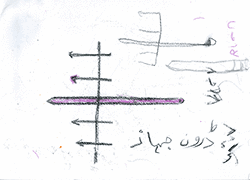

A drawing of a US drone by nine-year-old Nabeela ur Rehman.
Finally, it bears noting that this breakdown in narrative perspective reflects drone warfare’s termination of the territorially delimited monopoly of legitimate violence claimed by the nation-state itself. In Imagined Communities (1983), the late Benedict Anderson famously credited the dissemination of mass-produced novels with the creation of “national print-languages,” which served as the scaffolding for emerging nationalisms. These borders are now regularly transgressed by flying machines capable of delivering sovereign violence from afar: mass-produced novels about drone war reflect this undone nationalism at the level of their own imaginative infrastructure.
To the compensatory late-imperial fables by Maden and Clarke we might oppose critical artworks about mediation and violence by Behroz, Bilal, Paglen, and others. We might also array against them the testimony of people like Faheem Quereshi, a fourteen-year-old boy whose skull was fractured and eye destroyed by shrapnel in a 2009 drone strike in Pakistan, one of President Obama’s first “signature strikes.” Quereshi’s first-person account comes at the end of one section of Stanford’s long 2012 report Living Under Drones. The section is called “Voices from Below”: “I could not think,” reports Faheem. “I felt my brain stopped working and my heart was on fire.” In the words of another voice from below: “I started weeping. Lots of people there were weeping … weeping fiercely.”33
Henry Havelock, “Telegram from Havelock to Calcutta,” August 17, 1857, British Library, India Office Select Materials, MSS Eur 124/19, unpublished MS.
Giovanni Arrighi, The Long Twentieth Century: Money, Power, and the Origins of Our Times [1994
Ibid. Arrighi’s final book, Adam Smith in Beijing, points to the future his analysis imagined beyond American hegemony. The Braudel quote comes from Fernand Braudel, Civilization and Capitalism, 15th–18th Century: The Perspective of the World, Vol. 3, trans. Sian Reynolds (Berkeley: University of California Press), 1992.
Hannah Arendt, On Violence (New York: Harcourt Brace, 1970), 53.
Roger Stahl, “What the Drone Saw: The Cultural Optics of Unmanned War,” Australian Journal of International Affairs, Vol. 67, No. 5 (2013): 659–674; 659.
Ibid., 663.
Gregoire Chamayou, A Theory of the Drone (New York: The New Press, 2013), 38–39.
Loren Thompson, “Air Force’s Secret ‘Gorgon Stare’ Program Leaves Terrorists Nowhere To Hide,” Forbes, April 10, 2015 →
Edward Said, Culture and Imperialism (New York: Vintage, 1994), 63.
Ibid., 77, emphasis added.
Julian Stallabrass, “Negative Dialectics in the Google Era: A Conversation with Trevor Paglen,” October 138 (2011): 3–14; 4. See also Paglen, “Is Photography Over?,” Fotomuseum: Still Searching, March 3, 2014 →
Pierre Bourdieu, The Field of Cultural Production: Essays on Art and Literature (New York: Columbia University Press, 1984), 3, 4.
Mike Maden, Drone (New York: G. P. Putnam’s Sons, 2013), 15.
Bookscan reports that sales in this new subgenre have yet to storm the culture industry, though the numbers would be the envy of many academics. Maden’s series has sold around 23,600 copies (Drone, 6493 hardcover and 9838 paperback; Drone Command, 609 hardcover; and Blue Warrior, 1285 hardcover and 5469 paperback). Clarke’s Sting of the Drone has sold around 7,600 copies (4849 hardcover and 2760 paperback). And the literarily aspirational Fesperman clocks in last, at around 1,250 copies (985 hardcover and 268 paperback). By comparison, Tom Clancy’s latest book, Commander In Chief, has sold a little over 145,000 copies. I thank Sam Douglas and Becky Cole for tracking down these figures.
Maden, Drone, 17.
Ibid.
Ibid., 353.
Ibid., 32, 37.
Ibid., 158.
“Global Vigilance, Global Reach, Global Power for America,” US Air Force website, 2014, 7, emphasis in original →
Richard A. Clarke, Sting of the Drone (New York: St. Martin’s, 2015), 10. Unlike in earlier phases of infantry warfare, now doughy, effeminate bureaucrats and (as the newspaper articles so often point out) office workers who commute home at 5 p.m. exercise the state’s capacity to kill. Clarke’s non-hero is called Dougherty, fairly advertising this, while Erik Parsons, the CO of the doughboy’s unit of suburban killers, is described in the mode of mock-heroic: “If pilots were supposed to look like the cartoon hero Steve Canyon, tall and blonde, Erik Parsons looked more like a wrestling coach” (4).
Ibid., 6.
Ibid., 8.
Ibid., 8–10.
Ibid., 10.
Maden, Drone, 406.
Ibid., 412.
Ibid., 413, emphasis added.
Quoted in Audrey Jaffe, Vanishing Points: Dickens, Narrative, and the Subject of Omniscience (Berkeley: University California Press, 1991), 15.
Maden, Drone, 365, 221.
Clarke, Sting, 31–32, emphasis added.
Maden, Drone, 170.
International Human Rights and Conflict Resolution Clinic (Stanford Law School) and Global Justice Clinic (NYU School of Law), Living Under Drones: Death, Injury, and Trauma to Civilians from U.S. Drone Practices in Pakistan, September 2012, 70, 65.
